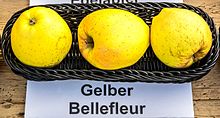Yellow Bellefleur
| Yellow Bellefleur | |
|---|---|
| Synonyms | Westfield Seek-no-Further , Yellow Bellefleur , Linnoeus Pippin , Metzger's Calvill |

|
|
| Art | Cultivated apple ( Malus domestica ) |
| group | Calville |
| origin | New Jersey , USA |
| known since | before 1840 |
| ancestry | |
| List of apple varieties | |
The Yellow Bellefleur is a variety of the cultivated apple . The name was given after the beautiful blossom ( Bellflower ) of the variety. Synonyms and foreign language terms are: Westfield Seek-no-Further , Yellow Bellefleur , Linnoeus Pippin , Metzger's Calvill .
Lineage and Distribution
The variety comes from America and has its origin in the state of New Jersey . In 1874 the Yellow Bellefleur was recommended for cultivation by the German Pomologists Association in Trier.
The variety 'Gelber Bellefleur' is currently listed on the Red List of endangered native crops in Germany . This red list includes all species groups of indigenous useful plants and their varieties, local varieties and varieties that were adapted to local conditions in Germany and were of importance.
Expectations
The variety grows moderately, has thin shoots. The fruitwood are long fruit canes that can never be cut. Just thin out and later rejuvenate. The variety is abundant and shows little tendency to alternate , blooms late from mid-April to late May. The yellow Bellefleur can also be recommended for planting where the soil is only light or mediocre. Well suited for high, half and low trunks. On dwarf trunks, pyramids and palmettes, the fruits are particularly beautiful and large. It is not suitable for the trellis , as the tree does not tolerate a short fruit wood cut well.
properties
The yellow Bellefleur is medium to large, conical, with 5 distinct ribs that run from the calyx to the center of the fruit. The basic color is yellow-green, the top color takes on a brownish-red tinge on the sunny side with increasing maturity. The numerous peel points are medium-sized, angular and light brown. The apple itself has no noticeable odor. The meat of the variety is yellowish-white, mildly spiced, somewhat vinous or quince-like and slightly sweet.
The variety is an excellent table and commercial apple , which is ready for storage in November and lasts until March. It must not be harvested too early.
The yellow Bellefleur is a good pollen producer .
Diseases
In wet years and on damp ground, fruit tree cancer and scab susceptibility are common.
Individual evidence
- ^ Wilhelm Lauche : German pomology (6 volumes) from 1850, content online
- ^ Eduard Lucas & Johann Georg Conrad Oberdieck : Ilustrites Handbuch der Obstkunde, first volume: Apfel Eugen Ulmer, Stuttgart 1875, p. 69, no. 19th
- ↑ http://pgrdeu.genres.de/rlist , Red List of the Federal Office for Agriculture and Food , accessed on April 28, 2016
- ^ Herbert Petzold, Apple varieties. Neumann publishing house . 1979, p. 102
- ^ Theodor Engelbrecht : Germany's apple varieties. Illustrated systematic representation of the apple varieties grown in the area of the German Pomologists Association . Ms. Viehweg und Sohn, Braunschweig 1889, p. 131, no. 117
- ↑ Without author: color plates from the supplement of the illustrated weekly newspaper Nach der Arbeit , 1935–1956, plate no. 112
Web links
- Noah's Ark : Yellow Bellefleur (PDF file; 530 kB)
- BUND Lemgo's fruit variety database: Gelber Bellefleur

